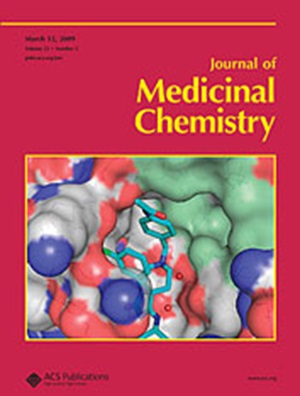非天然氨基酸:药物化学和药物发现中的策略、设计和应用
IF 6.8
1区 医学
Q1 CHEMISTRY, MEDICINAL
引用次数: 0
摘要
肽可以作为治疗剂发挥作用,处于小分子和大型生物制剂之间的特殊空间。尽管肽具有调节受体和调节疾病通路的潜力,但开发具有类似药物特性的肽仍然是一项挑战。在寻求优化理化参数和提高靶向选择性的过程中,非天然氨基酸(UAAs)已成为肽类药物和肽仿生药物的重要工具。除了硼替佐米和西他列汀等小分子药物外,甲基多巴、巴氯芬和加巴喷丁等临床批准药物也说明了非天然氨基酸的效用。在本《视角》中,我们概述了UTAs在FDA批准药物及其靶点中的战略和部署。我们进一步介绍了使用 UAAs 调节肽的理化性质。最后,我们将阐明这些改进的药理参数和 UAAs 所发挥的作用如何影响临床前阶段类似物的研究进展,并重点介绍 UAAs 所发挥的作用。本文章由计算机程序翻译,如有差异,请以英文原文为准。

Unnatural Amino Acids: Strategies, Designs, and Applications in Medicinal Chemistry and Drug Discovery
Peptides can operate as therapeutic agents that sit within a privileged space between small molecules and larger biologics. Despite examples of their potential to regulate receptors and modulate disease pathways, the development of peptides with drug-like properties remains a challenge. In the quest to optimize physicochemical parameters and improve target selectivity, unnatural amino acids (UAAs) have emerged as critical tools in peptide- and peptidomimetic-based drugs. The utility of UAAs is illustrated by clinically approved drugs such as methyldopa, baclofen, and gabapentin in addition to small drug molecules, for example, bortezomib and sitagliptin. In this Perspective, we outline the strategy and deployment of UAAs in FDA-approved drugs and their targets. We further describe the modulation of the physicochemical properties in peptides using UAAs. Finally, we elucidate how these improved pharmacological parameters and the role played by UAAs impact the progress of analogs in preclinical stages with an emphasis on the role played by UAAs.
求助全文
通过发布文献求助,成功后即可免费获取论文全文。
去求助
来源期刊

Journal of Medicinal Chemistry
医学-医药化学
CiteScore
4.00
自引率
11.00%
发文量
804
审稿时长
1.9 months
期刊介绍:
The Journal of Medicinal Chemistry is a prestigious biweekly peer-reviewed publication that focuses on the multifaceted field of medicinal chemistry. Since its inception in 1959 as the Journal of Medicinal and Pharmaceutical Chemistry, it has evolved to become a cornerstone in the dissemination of research findings related to the design, synthesis, and development of therapeutic agents.
The Journal of Medicinal Chemistry is recognized for its significant impact in the scientific community, as evidenced by its 2022 impact factor of 7.3. This metric reflects the journal's influence and the importance of its content in shaping the future of drug discovery and development. The journal serves as a vital resource for chemists, pharmacologists, and other researchers interested in the molecular mechanisms of drug action and the optimization of therapeutic compounds.
 求助内容:
求助内容: 应助结果提醒方式:
应助结果提醒方式:


